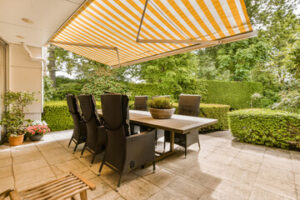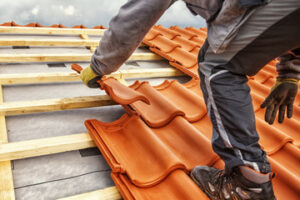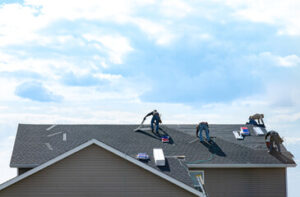Awnings Boise ID are a stylish addition to any outdoor space, offering shade and protection against the elements. They’re available in a wide range of materials, from canvas to acrylic fabrics and even aluminium.

They’re practical too, blocking sunlight from entering windows and preserving interior furnishings such as rugs and sofa upholstery from premature fading. They can also lower the inside temperature, saving energy in summer.
Awnings are built from many different fabrics, each with its own unique qualities and benefits. Choosing the right fabric can help to protect your property, create an inviting aesthetic, and reduce your energy costs.
Awning fabrics come in a variety of colors, styles and materials, and can be customized with additional features like valances and trims. Some of the most popular awning fabrics are cotton, acrylic, and vinyl. Each type of fabric has its own pros and cons, but determining the best fabric for your project is mostly a matter of personal preference.
When deciding on the best awning fabric for your project, consider factors like colorfastness, durability and water resistance. The fabric you choose should also withstand the weather conditions where your home or business is located. In general, it’s best to avoid fabrics that absorb moisture, as this can cause mold and mildew that can damage the awning and even the structure beneath it.
Synthetic fabrics are a great choice for awnings because they’re highly resistant to water, mildew and mold, as well as UV radiation. They can also withstand high winds and other environmental elements. In addition to being durable, most awning fabrics are easy to clean and can be customized with graphics to enhance the look of your space.
There are several types of synthetic awning fabrics available on the market today, including solution-dyed acrylics, polyesters, and vinyl. Solution-dyed acrylics are dyed all the way through, making them more fade-resistant than coating-based fabrics. They’re also soft to the touch and more resilient against scratches, tears and abrasions.
The fibers used in polyester and vinyl awning fabrics are often treated with special chemicals to make them more resistant to mold, mildew, stains, and water. Some fabrics are also treated with fire retardants, which can provide a layer of protection against flames and smoke. Awning fabrics can be decorated with graphics like heat-transfer film, eradication and silkscreening.
Whether you prefer a natural or synthetic awning fabric, Herculite Products can help you find the perfect option for your project. They offer a wide range of brands, products, design, marketing and technical expertise to help you make the best decision for your needs.
Retractable Awnings
Retractable awnings provide homeowners with a range of benefits, making it easy to turn any outdoor space into an inviting and comfortable extension of their home. They can protect against sunlight, which not only makes outdoor spaces more livable and enjoyable, but also helps lower energy costs.
With the push of a button, they can be extended to block out harsh sun, transforming outdoor living spaces into a cool and shaded oasis ideal for relaxing, dining, or entertaining. Awnings can even be used to protect hot tubs and pools, allowing users to take advantage of them even on the hottest days.
Depending on the style and fabric chosen, retractable awnings are available in a variety of configurations. One popular option is a semi-cassette model. This type features a partial casing over the fabric to reduce dust, rain, and UV exposure, while still allowing for easy cleaning. It’s an ideal choice for homeowners seeking moderate protection and affordability, or who aren’t ready to invest in a full-cassette model.
Another option is a drop arm retractable awning. This type is comprised of a weather-resistant fabric attached to a roller tube with spring-loaded side arms. When extended, they can cover a large area of a deck or patio. When retracted, they can be rolled up in a compact profile to minimize their visual impact.
Retractable awnings can be upgraded with wind sensors, which automatically retract them when the wind speed reaches a predetermined level. These are especially useful when a homeowner wants to enjoy their awning, but doesn’t want to deal with the hassle of manually retracing it. They can also be added to a simple shade series or performance series model to enhance functionality.
When shopping for a retractable awning, be sure to choose a retailer with a wide selection of colors and styles. A reputable retailer will be happy to help you select the perfect awning for your needs and taste, as well as provide options that complement your home and yard. They can also assist with installation and future servicing, which is important in ensuring the long-term durability of your investment.
Fixed Awnings
When it comes to adding shade and architectural character to your Phoenix and Prescott area home, there are many different types of awnings to choose from. However, choosing the right style will depend on factors such as your needs, the surrounding environment, and your design goals. Awning styles range from traditional fixed awnings to retractable awnings that offer added flexibility.
Residential awnings can be made of either aluminum or fabric. Awnings made of aluminum have a more streamlined appearance that integrates well with the home’s exterior and may be preferred by homeowners who want to make a statement with their shade solution. In addition, the lightweight material makes them easier to maintain and move around if necessary. Awnings with fabric covers, on the other hand, can be customized with a variety of colors and patterns to complement any home.
Choosing the right type of awning can also help to protect against sun damage and reduce the amount of heat that enters your home during the day. Awnings filter incoming light, which helps prevent furniture and carpeting from fading while also reducing the impact of sunlight on your home’s heating and cooling systems. When it comes to installing an awning, consider factors such as the home’s orientation and whether it receives direct sunlight throughout the day.
Window awnings are a common choice for homeowners looking to provide shade for their windows and doorways. These awnings are typically curved and sized to fit the width of the window or doorway. They are a good option for areas that receive excessive sunlight and may require extra protection during the winter months.
Other types of awnings include patio awnings, which are used to add shade to a deck or other outdoor space. These awnings can be a stylish way to bring the outdoors in and can also be a great place for entertaining guests or relaxing in the sun. They are often installed over large patios to provide additional living space, and they can be equipped with lighting for added appeal.
Custom Awnings
Unlike stock awnings from big box stores, custom awnings are designed specifically for your space. The size, style and color of your awnings depend on the type of area you want to cover. Do you need your awnings to be closer to your windows, providing only sun/UV protection, or do you want them to provide shade to an entire patio or deck space? This will help you determine the best frame, fabric and location for your awnings.
Awnings not only add style and value to a home, they also increase the energy efficiency of your home or business by keeping the heat, glare and UV rays out. This reduces indoor temperatures, thereby decreasing your utility bills and the use of air conditioning.
Aside from protecting against the elements, your awnings can be customized with features such as drop valances, bug screens and wind sensors to create a unique and personal design. You can even choose from various frame colors, fabrics and options to enhance the durability of your awnings.
If you are building or purchasing a home or business in Charleston, custom awnings can be a great way to maximize the use of your outdoor spaces. In addition to adding visual appeal, they can also be used to create a comfortable reading nook or sheltered play area for children.
Coastal Canvas Products has been creating and installing awnings since 1975. Our family-owned and operated company handles every aspect of the awning process in-house, from CAD design to manufacturing and installation. This allows us to provide greater quality control and responsive customer service for our clients.
Whether you are looking to improve your outdoor space at home or your commercial space, we can help. Our professional installers are trained to understand your needs and recommend the right awning solution. We will take the time to measure your space, select the right fabric and frame, and install it so that you can enjoy it for years to come.

